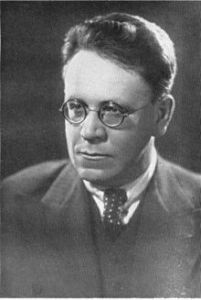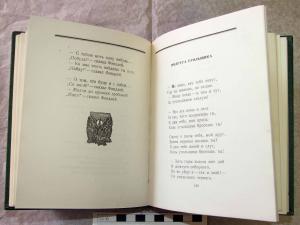Ayr
Burns on Beasties
On the BBC’s website it is listed that there are 118 poems written by our beloved bard Robert Burns with the theme of nature, however, I would argue that there is so many more as nature – a subject which was very close to his heart – is inextricably intertwined in a number of his works.
The reason nature is a genre featured so heavily within Burns’s works can be traced back to his upbringing and lifestyle. Being born in the but-and-ben Burns Cottage in Alloway, he was introduced to the ways of farmlife from childhood. He worked with his family closely there and at multiple farms thereafter such as Mount Oliphant and Lochlea Farm. Burns and his brother Gilbert even farmed at Mossgiel Farm when his father died. He did not just have connections with the land in his younger years but as an adult as well as he worked as a farmer alongside his career as a poet and songwriter. His last farming endevaour was at Ellisland Farm in Dumfrieshire. His rural upbringing and argicultural employment earned him his nickname as “The Ploughman Poet” by the artistocratic society of Edinburgh. Burns lived in Edinburgh for only two years – the city which he described as “noise and nonsense” – to return to his rural roots.
Firstly, I would ask: what is nature? It is defined as the phenomena of the physical world collectively, including plants, animals and the landscape. Burns did not neglect any of these three aspects and used them frequently as the inspiration of his works. He did various works which refer to plants such as To a Mountain Daisy, My Luve is Like a Red Red Rose and The Rosebud. Some of my personal favourite works of Burns which talk about other environmental features include Sweet Afton (about a river) and My Heart’s in the Highlands (which of course is about one of the most rugged, scenic and breath-taking landscapes in the world).
However, what this blog will mainly focus on is that Burns was most notably an animal lover. This is conveyed in his works On Glenriddell’s Fox Breaking his Chain, The Wounded Hare, Address to a Woodlark, The Twa Dogs, To a Louse and the renowned and much adored To a Mouse. This last poem – which was written in 1786 and published in the Kilmarnock Edition – is a perfect example of Burns’s humanity as this poem reflects his concern for animal welfare, his consciousness of humankind’s effect on nature and has empathy for a small creature which is widely considered as “vermin”. This was very ahead of his time and is a concern that is currently proving to be a huge issue as more and more animals become extinct because of human’s destructive actions in the twenty-first century.
The Twa Dogs poem, written in 1796, is another great work of Burns’s which gives the two dogs human-like intellect and the ability to express themselves as it has an upper-class pedigree, Caesar, and an ordinary working collie, Luath, who chat about the differing lives of the social classes. The name “Luath” comes from Ossian’s epic poem Fingal. The Twa Dogs immortalizes Burns’s own dog Luath who came to a cruel end. On the morning of 13th February 1784 Robert and his sister Isabella were distressed to find the poisoned body of Robert’s dog Luath outside their door – the act of a vengeful neighbour. Arguably, Burns intended this poem as a memorial to his canine friend.
An example of one of Burn’s lesser-known poems is The Wounded Hare which was written in 1789. Below are the first three stanzas out of five that complete this poem:
Inhuman man! curse on thy barb’rous art,
And blasted be thy murder-aiming eye;
May never pity soothe thee with a sigh,
Nor ever pleasure glad thy cruel heart!
Go live, poor wand’rer of the wood and field!
The bitter little that of life remains:
No more the thickening brakes and verdant plains
To thee a home, or food, or pastime yield.
Seek, mangled wretch, some place of wonted rest,
No more of rest, but now thy dying bed!
The sheltering rushes whistling o’er thy head,
The cold earth with thy bloody bosom prest.
The word choice makes the moral message of this poem is clear: Burns is vehemently opposed to shooting. The passion and intensity of Burns’s thoughts on this is quite surprising as one would think that as a farmer he would be used to or even dependent on killing animals, however, meat consumption was not as prominent in the eighteenth century as farm animals were only killed for food in old age or special occasions. The family’s provision of milk, cheese, butter and wool came directly from their own animals, and the health and wellbeing of these creatures were paramount. Furthermore they would share the same roof over their heads with them, thus creating strong bonds with their farm animals, and apparently Burns lost his temper with a farm-worked once when the man did not cut the potatoes small enough and Burns was frantic that the beasts might choke on them.
Below is the third stanza of the powerful poem On Glenriddell’s Fox Breaking His Chain written in 1791:
Glenriddell! Whig without a stain,
A Whig in principle and grain,
Could’st thou enslave a free-born creature,
A native denizen of Nature?
How could’st thou, with a heart so good,
(A better ne’er was sluiced with blood!)
Nail a poor devil to a tree,
That ne’er did harm to thine or thee?
Again, you can clearly see that Burns is opposed to the cruel treatment of a “free-born creature” and is in disbelief of the actions of the good-hearted Glenriddell’s actions.
However, one could argue that nature was so deeply rooted in Burns’s psyche – and he quite literally was surrounded by it living on a farm – that he could not escape from being inspired to write about it. An example of this is in his masterpiece Tam o’ Shanter. It is an epic narrative poem written in 1790 which features folklore, superstition, witchcraft and gothic themes… but it also has one of his most poignant and beautiful quotes in which Burns really philosophically details the nature of nature:
But pleasures are like poppies spread,
You seize the flower, its bloom is shed;
Or like the snow falls in the river,
A moment white–then melts for ever;
Or like the borealis race,
That flit ere you can point their place;
Or like the rainbow’s lovely form
Evanishing amid the storm.–
Nae man can tether time or tide;
The hour approaches Tam maun ride;
Burns is saying that nature’s beauty is wistful, forever-changing and is out of the control of humankind as he insightfully states “nae man can tether time or tide”.
In terms of this poem, another point is worth mentioning: the hero of this tale is a horse. Again Burns’s admiration and respect for animals is encompassed in the heroism of Meg, Tam’s horse, who against all odds does get him home in one piece although the same cannot be said for her. Burns was a brilliant horse-rider and would have relied heavily on his four-legged companion as a mode of transportation to socialise, to plough fields and to work as an excise man.
All in all Burns would have been regarded nowadays as an advocate for animal welfare and his works which have animals or nature at their core reflect his love for nature and are some of his most passionate, most thought-provoking and most heart-rending.
By Parris Joyce (Learning Trainee)
‘The descendant of the immortal Wallace’

Throughout his life, Robert Burns was inspired by women. He grew up listening to the Scottish songs and folklore of his mother, Agnes, and distant cousin, Betty Davidson; fell in love time and again with a new bonnie lassie; and fathered several much loved daughters of his own who inspired his affections and poetry. Few relationships however are as well documented or as important to his works as his friendship with Mrs Frances Anna Wallace Dunlop, whose support and patronage were invaluable to the Bard for the majority of his publishing life.
Born in 1730, Frances Anna Wallace was the eldest daughter of Sir Thomas Wallace of Craigie and Dame Eleanora Agnew. Sir Thomas claimed to have been a descendant of Sir Richard, cousin of William Wallace – a connection which Burns was later delighted by. At the age of 17, Frances married John Dunlop of Dunlop and the couple went on to have 7 sons and 6 daughters. Their happiness was not to last however, as John died in 1785 resulting in Frances falling into a ‘long and severe illness, which reduced her mind to the most distressing state of depression’. This would have been an affliction Burns was also all too used to.
It was as she was recovering from this illness that a friend gave her a copy of The Cotter’s Saturday Night to read. So delighted was she with it that she sent, according to Gilbert Burns, ‘a very obliging letter to my brother, desiring him to send her half a dozen copies of his Poems, if he had them to spare, and begging he would do her the pleasure of calling at Dunlop House as soon as convenient’. The Bard responded by sending her 5 copies of his Kilmarnock Edition and a promise to call on her on return from his trip to Edinburgh. It was the start of a very important friendship.
Burns visited Mrs Dunlop at least five times throughout his life, and wrote more often to her than any other correspondent, sending her copies of his poems and drafts of letters intended for others. She in return wrote to him of her family troubles, as well as counselling him on career choices and urging him to modify what she described as his ‘undecency’ in relation to his affairs with women. She described his correspondence as ‘an acquisition for which mine can make no return, as a commerce in which I alone am the gainer; the sight of your hand gives me inexpressible pleasure…’ It would appear, in saying this, that she underestimated the value Burns placed on her friendship, as his increasingly desperate attempts to illicit a response from her after their falling out demonstrate.
This falling out occurred in 1794. With two of her daughters marrying French refugees and various members of her family having army connections, Mrs Dunlop had hinted at her disapproval of Burns’s apparent sympathies with revolutionaries in France in previous correspondence. He failed to take the hint and wrote in a letter of December 1794, referring to King Louis and Marie Antoinette, ‘What is there in the delivering over a purged Blockhead & an unprincipled Prostitute to the hands of the hangman, that it should arrest for a moment, attention in an eventful hour…?’ This offence was a step too far.
Burns sent Mrs Dunlop two further letters without reply, apparently completely oblivious to what could have caused her anger. ‘What sin of ignorance I have committed against so highly a valued friend I am utterly at a loss to guess’ he wrote in January 1796, ‘…Will you be so obliging, dear Madam, as to condescend on that my offence which you seem determined to punish with a deprivation of that friendship which once was the source of my highest enjoyments?’ On receiving no response, his final letter to her was sent just days before his death informing her that his illness would ‘speedily send me beyond that bourne whence no traveller returns’ and bestowing praise upon her friendship. It is believed that she did relent on receiving this, and one of the last things Burns was able to read was a message of reconciliation from her.
Mrs Dunlop survived the poet by another 19 years, dying in 1815. Her friendship and patronage were hugely valued by Burns, and her impact on the poet’s life and works should be regarded as just as important as that of other key women in his life. She is buried in Dumfries, Scotland but her words and thoughts live on in her letters to Scotland’s National Bard.
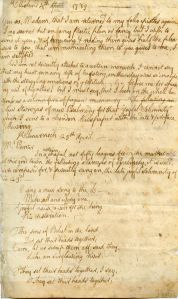
Robert Burns’s Seal
The creative talents of Robert Burns extended beyond his poetry and songs when he decided to design his own seal in 1794. In the medieval era a badge like this would have had aristocratic or militaristic origins. So why did a humble farmer poet, who was a believer in love rather than war, want a coat of arms? Burns’s creation can be seen imprinted in crimson wax and on his seal matrix within the exhibition collection at Robert Burns Birthplace Museum. This seal was a public declaration that Burns considered himself equal to any nobleman, and this would have given a clear signal to any that would have seen it. This was an important token of personal and familial identity for Burns, which he would have imprinted onto his letters.
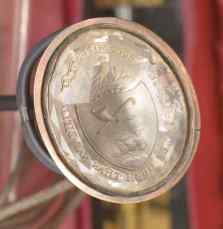
Burns decided to incorporate two mottoes within his seal. ‘Wood-notes wild’ is inscribed across the top of the seal, whilst along the bottom there is the phrase ‘Better a wee bush than nae bield’ (shelter). The first inscription could be signalling how nature has often been an important inspiration in his life, both visually and musically. He often said his wife Jean had the sweetest wood-notes wild singing voice. In the second motto Burns could be highlighting his fears of homelessness that frequently haunted him towards the end of his life. This reminds us to respect Mother Nature, as she can be a refuge for a wee mousie to all mankind as well. In the centre of these two mottoes Burns has placed a shepherd’s crook and pipe, signalling his lifelong connection to nature through his agricultural background.
One of the main elements in his design is a Holly Tree at the bottom. Perhaps Robert Burns wanted to display his love of nature prominently, or perhaps there is another layer of meaning to consider. In Celtic mythology a Holly Tree was a guardian in the dark, winter months. It was seen by the people as a symbol of peace and goodwill. Furthermore, the Druids believed that Holly possessed protective qualities and that it could guard against bad luck and evil spirits. Therefore, this could be Burns recalling his time as a child when he heard stories of folklore and superstition from his mother and Betty Davidson.
A woodlark is a symbol of cheerfulness and joy even in the worst of times, something that Burns would have related to as his own spirits rose and fell throughout his life. But the similarity between Burns and the woodlark does not end there, since this particular song bird can mimic and remember other birds’ songs. Burns was a great lover of songs and music since boyhood, so in order to preserve the traditional songs of his beloved Scotland; Burns dedicated himself to collecting them. These were gathered together and published in an anthology called Scots Musical Museum by James Johnson over several years.
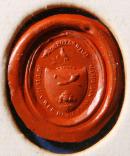
In the closing decade of the eighteenth century, discussion on republicanism and equality were politically rife questions. Robert Burns did not meet the requirements to vote; as such he used his pen and voice to challenge the political authority of the time. In his seal matrix Burns has placed a woodlark upon a branch of bay leaves. In Roman mythology bay leaves were treasured by the Gods, as their crowns of bay leaves connoted their high status and glory. By placing a woodlark, a song bird like himself on top of the branch, Burns could be trying to say his voice has greater potency then the established authority. In addition to this, it could also be interpreted as a form of mockery, as a single songbird could undermine the glory of those in power with his voice alone.
Burns deliberately incorporated multiple layers of meaning within several of his poetical works, and this mastery of disguising his true intention could also be said for his seal. Did he choose these symbols as a way of showing the world how he saw himself or how others saw him? Whether you believe these symbols have multiple meanings or not, it still provides an insight into how Burns wanted to be portrayed and remembered. He was a lover of nature and song, and even in his height of popularity amongst the literati of Edinburgh he never forgot his farming roots, which is evident in the shepherd’s pipe and crook in the centre. Nevertheless Robert Burns was a man not afraid to aspire beyond his supposed class, and this small seal and wax impression is evidence of this.
By Kirstie Bingham
The ‘Heaven taught ploughman’?
‘Though I am far from meaning to compare our rustic bard to Shakespeare, yet whoever will read his lighter and more humorous poems, … , will perceive with what uncommon penetration and sagacity this heaven taught ploughman, from his humble unlettered station, has looked upon men and manners. – Henry MacKenzie
At the age of 6, a young Robert Burns was sent to school at Alloway Mill to be taught by a William Campbell. The Bard’s father, William Burnes, was a great believer in his children’s education and wanted to ensure they received proper schooling. Unfortunately this was to prove tricky as Campbell the village left shortly afterwards. Not to be deterred, William Burnes approached Ayr Grammar School and requested a private tutor, John Murdoch, to teach his boys alongside 4 other families in the village, and to take turns to board in each of their houses.
Murdoch was a young man of eighteen himself, but struck up a firm friendship with William and enjoyed teaching the boys. Even after the family left Burns Cottage, they continued to attend Murdoch’s school in the village for two years. At this point, Murdoch left the area, but returned in 1772 and taught Robert Burns further, particularly French and English grammar. He also gifted him the works of Alexander Pope, whom Burns quotes frequently in subsequent letters and admired greatly.
Gilbert Burns wrote extensively on his former teacher, and credits him with inspiring Robert’s love of reading:
‘With him we learned to read English tolerably well; and to write a little. He taught us, too, the English grammar; but Robert made some proficiency in it, a circumstance of considerable weight in the unfolding of his genius and character; as he soon became remarkable for the fluency and correctness of his expression, and read the few books that came in his way with much pleasure and improvement; for even then he was a reader when he could get a book. Murdoch, whose library at that time had no great variety in it, lent him the Life of Hannibal, which was the first book he read (the school-books excepted), and almost the only one he had an opportunity of reading while he was at school.’ – Gilbert Burns
Murdoch himself wrote of his time teaching the Burns boys, in which he was less than complimentary about the Bard’s singing abilities, and confesses that he would have thought Gilbert more likely to develop into a famous poet:
‘Robert’s ear, in particular, was remarkably dull, and his voice untunable. It was long before I could get them to distinguish one tune from another. Robert’s countenance was generally grave and expressive of a serious, contemplative and thoughtful mind. Gilbert’s face said, “Mirth with thee I mean to live”; and certainly if any person who knew the two boys had been asked which of them was most likely to court the Muses, he would surely never have guessed that Robert had a propensity of that kind.’ – John Murdoch
In 1776, a complaint was made against John Murdoch that he had insulted the local church minister, William Dalrymple, and the former was forced to leave the village. He moved to London, where he actually assisted with the funeral arrangements of Burns’s younger brother William, who he had met with shortly before William’s death. Unfortunately for Murdoch, he died himself in 1824 in extreme poverty.
Thanks to the determination of his father and the dedication of John Murdoch, Robert Burns received a considerable formal education in his youth. This fostered his love of literature, and allowed him to develop the social and political knowledge necessary for writing some of his greatest works. Far from being a ‘heaven taught ploughman’ as MacKenzie suggests in his review of the Kilmarnock Edition in 1786 (see top of blog), Robert Burns received excellent schooling for the time, and was able to put this to full use during his adult life.
Scots language at RBBM
Scots is one of three indigenous languages in Scotland alongside Gaelic and English. It is recognised as a language in its own right and Burns is recognised as one of the greatest proponents of this language. Here at RBBM, we utilise Scots to reinforce its relevance to the museum, its landscape and its local heritage. You can read more about our promotion and usage of our mither tongue in our Scots Language Strategy: http://www.burnsmuseum.org.uk/scots-language-strategy/.
If you have visited RBBM before, you may have spotted our use of the Scots language in our exhibition labels, products and books in our shop, and in our café menus. We also explore Scots in our education programmes, and it is part of our architecture – you’ll find Scots words engraved into the building’s walls, adorning our glass windows and incorporated into some of our exterior sculptural works. We would love to know which Scots words you have seen around the site are your favourite. Tweet us @robertburnsnts using the hashtags #Scots and #Scotslanguage to share.
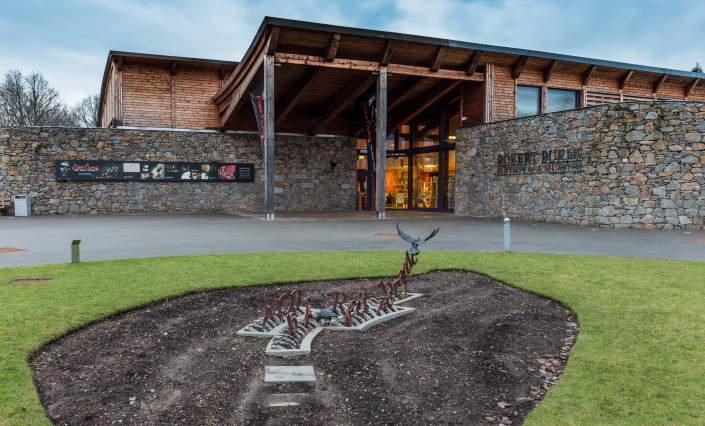
At the front of the Museum on the grass, you’ll find a bronze and steel sculpture rising from the leaf-shaped soil. This piece is by Tim Chalks for Chalk Works, and it is site-specific – designed to relate closely to the environment and the people associated with its location, much like Chalks’ other works. The form of this sculpture plays with the way Burns drew inspiration for his poems and songs – from the land – by ploughing Scots words taken from Burns’s To A Mouse from the earth. Further emphasis is placed on Burns’s concern with nature, and his farming background, by two bronze crows attempting to feed from the Scots words. This inclusion of feeding birds is fitting for RBBM too, especially as they are crows, one of the most intelligent types of bird, as we aim to fill (up) our visitors with the knowledge of Burns’s life and works, as well as of the richness of the Scots language.
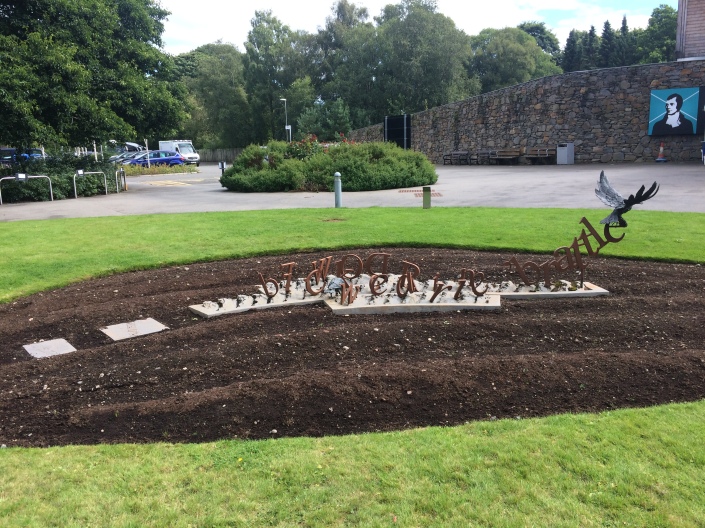
A crow at RBBM’s entrance, placed to direct visitors into the Museum from the grass, is also part of this sculpture by Chalks, as are the additional crows in the Museum Gardens. The Museum Gardens are also home to a selection of Chalks’ other sculptural works. Why not pop along to see them and explore what their interpretations may be?
By RBBM Learning Trainee, Sophie Watt.
An unwelcome neighbour?
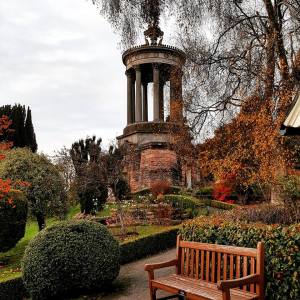
This blog was written by one of Robert Burns Birthplace Museum’s Visitor Service Assistants, Jim Andrews.
In his monograph History of Burns Monument, the Glasgow librarian J.C. Ewing, who was an authority on Burns and whose personal collection of Burns-related books we now have in our library, expressed his disapproval of a new building that was constructed near the monument:
The site [of Burns Monument], which is within half a mile of the Poet’s birthplace, was in every way an eminently appropriate one, though it was years afterwards marred by the erection of Alloway Church close to the Monument precincts, which still blocks the view from the principal line of approach. The Monument would be a beautiful feature in the landscape from this point of view, and seen at a favourable distance, and as the view from all other directions is circumscribed, one cannot help wishing the church in some other place where it would be equally convenient and useful, and where it would not be an eyesore to all enthusiasts of Burns.
Burns monument was completed in 1823: Alloway Parish Church in 1858. If he were alive today, I wonder if the church might have redeemed itself in Mr. Ewing’s eyes, as it now contains a feature that some visitors to the museum have asked me about and seem very keen to find: the Robert Burns Memorial Window. It is a modern stained glass window, installed in the church in 1996 to mark the bicentenary of the poet’s death. The iconography of the design, by the stained glass artist Susan Bradbury, is immediately obvious to Burns enthusiasts: the River Doon and the Brig o’ Doon, a ploughman walking behind a horse-drawn plough, various animals and plants that feature in Burns’s poems and, appropriately for a church, it also features the text of the first verse of Burns’s A Grace before Dinner.
O Thou who kindly dost provide For every creature’s want! We bless Thee, God of Nature wide, For all Thy goodness lent:
The church is also worth a visit for its other stained glass windows. With windows dating from the original building in 1858 through to the 21st century, it contains a history of Scottish stained glass in microcosm.
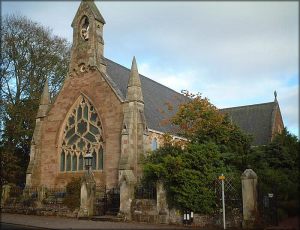
The story of the stained glass we can see in Scottish churches and cathedrals today starts with, at least from a heritage point of view, a disaster ― the Protestant Reformation of 1560. The violent and thorough iconoclasm of the Reformation deprived Scotland of the bulk of its heritage of the religious art of the Middle Ages. Not only the art, but also lost were the traditional skills of the artists and craftsmen, who found that they could no longer earn a living as they had done during the centuries when the church meant the Roman Catholic Church. The Reformation Kirk was an altogether plainer affair that did not require their particular skills. Robert Burns may never have seen a stained glass window in a church.
The Gothic Revival that began in the late 1700s and flourished throughout the 1800s in Britain brought a renewed interest in the art and architecture of the Middle Ages. It defined the architecture of the Victorian era, and has left a rich legacy of public buildings and churches. The stately homes and public buildings in the Scots Baronial style are an expression of the Gothic Revival in Scotland. The lost art of stained glass was needed once again to complete the neo-Gothic image. Attitudes in the Kirk had also changed, allowing Scotland to reconnect with its pre-Reformation heritage and bring stained glass back into its religious buildings.
Just how the lost art of stained glass came back to Scotland is not known with any certainty. The lives of the early Scottish pioneers are not documented. However, they probably learned the craft in England, where it had not entirely disappeared. They also adopted the English style; there were no surviving examples of stained glass from Mediaeval Scottish churches or cathedrals on which to base their designs. The major source of reference material in the 1850s was a two-volume publication written in 1847 on the mediaeval stained glass that had managed to survive the Reformation in England. England had also endured a period of iconoclasm during its Reformation, though fortunately not as thorough as in Scotland.
Alloway is fortunate to have a fine collection of stained glass in its church, dating from the Victorian era right up to the present century. However, elsewhere, Scotland’s heritage of Victorian church architecture and stained glass was sadly undervalued in the twentieth century. Glasgow’s heritage suffered particularly badly from the urban redevelopment programmes of the decades following the Second World War, which resulted in the demolition of many Victorian church buildings and the loss of many fine examples of early Victorian stained glass.
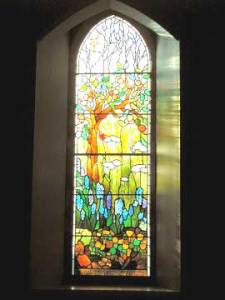
Every year a team of volunteers keeps Alloway Parish Church open during weekdays (provided the church is not required for a wedding or funeral) throughout the summer months of June, July and August, so that visitors can enjoy the stained glass windows, and in particular the Robert Burns Memorial Window.
New Gardens
In 1756 a farmer and landscape gardener called William Burnes took a perpetual lease on a 7 acre piece of land in Alloway. The next year, he started work on a small Cottage for himself and his wife, Agnes, and two years after that their first son Robert was born in its kitchen. 37 years later, Robert Burns died in Dumfries having cemented his place in history as Scotland’s National Bard.
William was an innovator. He had previously worked on the laying out of Edinburgh’s Hope Park (now the Meadows) and believed in agricultural and landscaping improvement. Although they only lived at Burns Cottage until young Robert was 7, it was always William’s dream to create a self-sufficient market garden, ‘New Gardens’ on the site. Unfortunately, his idea did not prosper and over time the land was given over more and more to cattle and poultry. It was with this in mind that the Robert Burns Birthplace Museum (RBBM) team decided to revisit William’s plans and restart ‘New Gardens’ as a working project.

The first steps were taken last year, with the planting of a 39 tree strong orchard which is already bearing fruit. Last week saw the beginning of the next stage of works, carried out by W L Straughan & Son Ltd, to install raised beds, public walkways, and a pond and wetland area. With this, we aim to improve biodiversity onsite, expand on the outdoor learning opportunities (for schools, families and community groups) RBBM currently offers, and to realise William’s ‘New Gardens’ vision and offer up an historic continuum on this plot of land between the time of Burns and the present.
In 1765, William Burnes leased land at Mount Oliphant farm about 2 miles away from Burns Cottage in Alloway, and the family moved there. Soil was poor and the family had to work hard to keep afloat. 12 years later, they moved to Lochlea Farm in Tarbolton, site of the Bachelors’ Club where Robert Burns learnt to dance, founded a debating society, and joined the Freemasons. Unfortunately, the family continued to find it difficult to make ends meet, and became involved in a legal dispute with their landlord. They eventually won the court case in 1784, but William was left physically drained and died just a few weeks afterwards.

233 years later, his New Gardens project is now underway at the Burns’s first family home in Alloway, and will allow RBBM to focus on another of William’s key passions – education – without which the boy born in 1759 in the kitchen of the auld clay biggin’ may never have gone on to become Scotland’s National Bard.





